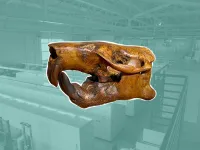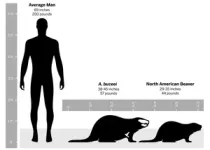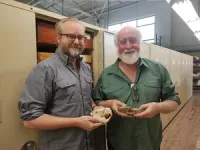(Press-News.org) A new species of ancient beaver that was rediscovered by researchers in The University of Texas at Austin’s fossil collections has been named after Buc-ee’s, a Texas-based chain of popular travel centers known for its cartoon beaver mascot.
The beaver is called Anchitheriomys buceei, or “A. buceei” for short.
Steve May, a research associate at the UT Jackson School of Geosciences, said that the beaver’s Texas connection and a chance encounter with a Buc-ee’s billboard are what inspired the name.
May is the lead author of the paper that describes A. buceei, along with another, much smaller, species of fossil beaver. Published in the journal Palaeontologia Electronica, the paper provides an overview of beaver occurrences along the Texas Gulf Coast from 15 million to 22 million years ago based on bones and archival records in the UT collections.
While driving down a highway in 2020, May spotted a Buc-ee’s billboard that said “This is Beaver Country.” The phrase brought to mind the Texas beaver fossils he had been studying at UT’s Texas Vertebrate Paleontology Collections.
“I thought, ‘Yeah, it is beaver country, and it has been for millions of years,’” May said.
A. buceei lived in Texas about 15 million years ago. To the casual observer, it probably wouldn’t have looked much different from beavers living in Texas today, according to study co-author Matthew Brown, the director of the Jackson School’s vertebrate paleontology collections. However, one key difference is size. A. buceei was bigger – about 30% larger than modern beavers – though still much smaller than the bear-size beavers that lived in North America during the last Ice Age.
The UT collections includes A. buceei fossils from six Texas sites. But most of what researchers know about the new fossil beaver comes from a unique partial skull from Burkeville, Texas. The fossil is a fusion of bone and brain cast that was created when sediment naturally seeped into the beaver’s brain cavity eons ago, creating a rock replica of the brain as the specimen fossilized.
High-resolution X-ray images of the skull obtained at UT Austin’s Computed Tomography Lab brought small anatomical details of the skull into clear view. These details helped May and Brown confirm that the skull belonged to a new species. But they weren’t the first to suspect it.
The skull was originally collected by a team of Texas paleontologists in 1941. One of them, Curtis Hesse, a museum curator at Texas A&M University, said in notes that he intended to name it a new species. However, Hesse died in 1945 before he could complete his study and publish his findings. Eighty years later, May and Brown, with the help of new technology and a better understanding of the fossil record of beavers, picked up where Hesse left off.
“New discoveries in the field capture lots of attention, but equally as valuable are the discoveries made in existing museum collections,” Brown said. “We know that these opportunities are littered throughout the drawers in these cabinets.”
After hearing about the ancient beaver named after his business, the founder and CEO of Buc-ee’s, Arch “Beaver” Aplin III, said that Buc-ee’s has a longer history in Texas than he initially thought.
“Buc-ee’s was founded in 1982, but we may need to rethink our beginnings,” he said.
The study was funded by the UT Jackson School of Geosciences and the Texas Historical Foundation.
END
Beaver fossil named after Buc-ee’s
2023-03-27
ELSE PRESS RELEASES FROM THIS DATE:
James Chappell wins NSF CAREER Award
2023-03-27
HOUSTON – (March 27, 2023) – Rice University bioscientist and synthetic biologist James Chappell has won a National Science Foundation CAREER Award to develop RNA programming methods to improve human health and the environment.
“Synthetic biology has progressed a lot in the past decade, and we’ve gotten really good at genetically programming microbes in confined laboratory environments where conditions are ideal,” said Chappell, an assistant professor both of biosciences and of bioengineering. “But, of course, most microbes on the planet don't live in pure cultures where the temperature is always 37 degrees ...
In bid to make child cancer treatments safer, scientists find possible warning signs of severe reaction
2023-03-27
Scientists seeking a way to eliminate an adverse reaction to treatments for acute lymphocytic leukemia, a common childhood cancer, have found what they believe to be an early warning indicator.
Mouse studies conducted by Rutgers researchers as part of a larger scientific team are pointing to vitamin A levels as a signal that a patient may or may not be vulnerable to a dangerous toxicity.
Summarizing their findings in Science Translational Medicine, the scientists found that, in patients being treated for acute lymphocytic leukemia with the chemotherapy drug asparaginase, there is an ...
HIV can persist for years in myeloid cells of people on antiretroviral therapy
2023-03-27
A subset of white blood cells, known as myeloid cells, can harbor HIV in people who have been virally suppressed for years on antiretroviral therapy, according to findings from a small study supported by the National Institutes of Health. In the study, researchers used a new quantitative method to show that HIV in specific myeloid cells—short-lived monocytes and longer-lived monocyte-derived macrophages—can be reactivated and infect new cells. The findings, published in Nature Microbiology, suggest that ...
The Greenland Ice Sheet is close to a melting point of no return
2023-03-27
American Geophysical Union
Press Release 23-11
27 March 2023
For Immediate Release
This press release is available online at: https://news.agu.org/press-release/the-greenland-ice-sheet-is-close-to-a-melting-point-of-no-return/
AGU press contact:
Rebecca Dzombak, +1 (202) 777-7492, news@agu.org (UTC-4 hours)
Contact information for the researchers:
Dennis Höning, Potsdam Institute for Climate Impact Research, dennis.hoening@pik-potsdam.de (UTC+1 hour)
WASHINGTON — The Greenland Ice Sheet covers 1.7 million ...
Chicago pollution varies by neighborhood
2023-03-27
New simulation combines emissions with weather and chemistry in an air-quality model
First neighborhood-scale simulation of its kind focused on Chicago tracks air quality hour by hour across areas as small as 1.3 kilometers-sized blocks
Simulation can show how pollutants move across space and time throughout the city and surrounding areas
Air pollution along highways is consistently worse than other areas, regardless of season or time of day
EVANSTON, Ill. — If you live along one of the major interstate highways running through Chicago or directly next to Lake Michigan, you are regularly exposed to more air pollution than ...
Moffitt researchers discover two-pronged approach to stimulate STING antitumor activity
2023-03-27
TAMPA, Fla. – Immunotherapies have greatly improved the outcomes of many patients with melanoma. But there is still a need for new approaches for the subset of patients who do not respond well to this type of therapy. Moffitt Cancer Center researchers are looking at new targets to help inhibit tumor development and promote antitumor immunity, one being the STING signaling pathway. In a new article published in Nature Communications, a team of Moffitt and University of Miami Miller School of Medicine investigators demonstrate that targeting the STING pathway with a combination strategy ...
Making immunizations more effective
2023-03-27
In addition to an antigen, many vaccines also contain substances, called adjuvants, which stimulate the immune system. By using computer-aided molecular design and machine learning, a Chinese research team has now developed two novel broad-spectrum adjuvants that can significantly amplify the immune response to vaccines. As reported in the journal Angewandte Chemie, they were able to enhance the effectiveness of immunization against certain forms of cancer in animal models.
Adjuvants amplify and prolong the effect of vaccine immunizations. Aluminum salts have been successfully used ...
JWST confirms giant planet atmospheres vary widely
2023-03-27
ITHACA, N.Y. – An international team of astronomers has found the atmospheric compositions of giant planets out in the galaxy do not fit our own solar system trend.
Using NASA’s James Webb Space Telescope (JWST), the researchers discovered that the atmosphere of exoplanet HD149026b, a ‘hot Jupiter’ orbiting a star comparable to our sun, is super-abundant in the heavier elements carbon and oxygen – far above what scientists would expect for a planet of its mass.
These findings, published in “High atmospheric metal enrichment for a Saturn-mass ...
Breakthrough Brain Imaging: Experts use new microscope, AI algorithm, and voltage indicators to image electrical activity deep in the brain
2023-03-27
When studying the brain, researchers are just beginning to use a method known as voltage imaging to track neural activity in the living animal. While this approach is a promising way to better understand neuron firing, behavior, and cognition, there are limitations and risk factors. The practice requires putting a lot of light into the brain (which can lead to overheating) and only has the capacity to image ten neurons at a time.
New research from Jerry Chen, a Boston University College of Arts & Sciences assistant professor of biology, and collaborators aims to address these challenges. Published today in Nature Methods, ...
RIT researcher receives funding to improve infrastructure safety for nuclear waste disposal
2023-03-27
Researchers at Rochester Institute of Technology are investigating the combined physical effects of heat, chemical reactions, and seismic activity on concrete lining structures used to dispose of nuclear waste. Results from the work could improve nuclear waste infrastructure designs, better long-term safety management, and refine strategies to meet climate change targets.
Lu Sun, a professor in RIT’s College of Engineering Technology (CET), received a grant of nearly $500,000 from the Nuclear Regulatory Commission for “High temperature and seismic response of concrete lining structures and clay in nuclear waste disposal.” ...





